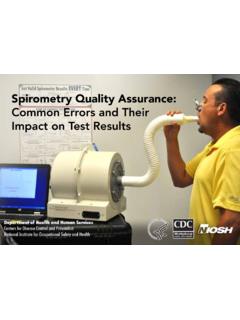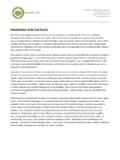Transcription of Pap test results - PapScreen
1 FOR WOMEN WITH AN ABNORMAL PAP TESTPap test results p|1 Illustrations on page 2, 4, 9 and 10 by Con Stamatis, Cancer Council This booklet provides women with information about abnormal pap test results . Many women feel anxious or worried when they are told their Pap test result is not completely normal. It is important to remember that almost all abnormal pap test results are not due to cancer. Not all problems need treatment, and those that do can be treated quite easily and usually very successfully. For many women with an abnormal result, only extra check-ups will be necessary.
2 For others, further tests and treatment may be required. It all depends on the type of abnormality that is detected. You need to discuss your results and the need for further tests or treatment with your doctor or nurse. However, we hope that this booklet will answer some of the questions you may have and help you when discussing your options. Some of the terms used in this booklet are explained in the glossary at the back. It is important to remember that almost all abnormal pap test results are not due to cancer and most will not need treatment. Contents 2 The Pap test 2 What is a Pap test?
3 3 How is a Pap test done?3 Why are Pap tests necessary?3 How effective is a Pap test?4 Types of cervical cells 6 pap test results 6 Unsatisfactory sample6 No endocervical cells present7 What an abnormal result means 7 HPV and abnormal Pap tests8 HPV testing 8 Low-grade and high-grade abnormalities8 Other abnormalities 10 What happens next? 10 Further Pap tests 10 Colposcopy 11 Biopsy 12 What treatment may be required? 12 Managing low-grade abnormalities 12 Managing high-grade abnormalities 13 Other abnormalities 13 Treatment methods 14 Making decisions about treatment14 Questions to ask your doctor 15 Care after treatment 16 Treatment and pregnancy16 Victorian Pap Test Registry17 Do I need more Pap tests ?
4 17 Things to remember 18 Human papillomavirus (HPV) vaccine20 Glossary p|3p|2 The Pap test What is a Pap test? A Pap test checks for cell changes on the cervix (neck of the womb), at the top of the vagina. It is a screening test to find early warning signs that cancer might develop in the future. If abnormal changes are found, further tests may be recommended to see if treatment is needed. The Pap test is not a test to diagnose cancer, but rather to find the early changes which might become cancer later. All women should have their first Pap test a year or two after commencing sexual activity or at the age of 18, whichever comes later.
5 Pap tests should then be continued every two years until the age of 70, unless advised otherwise. As cervical cancer usually takes up to 10 years to develop, there is no advantage in having a Pap test more often than every two FEMALE REPRODUCTIVE SYSTEMOVARY FALLOPIAN TUBE UTERUS (WOMB) VAGINA CERVIX (NECK OF WOMB) How is a Pap test done? A Pap test is a quick and simple procedure in which a doctor or nurse gently inserts an instrument called a speculum into the vagina. This allows the cervix to be clearly seen. A small sample of cells is taken from the cervix and placed (smeared) on a glass slide.
6 The slide is then sent to a laboratory where it is examined under a microscope. The result usually comes back to your doctor or nurse within two weeks. Ask when you should contact your doctor or nurse to find out your are Pap tests necessary? Pap tests detect early changes on the cervix that may be the first warning signs that a problem is occurring. These changes need to be monitored. In a small number of cases treatment is necessary, as some abnormal cells may develop into cancer if left untreated. How effective is a Pap test? Regular Pap tests every two years can prevent the most common type of cervical cancer in up to 90% of cases.
7 Like all screening tests , the Pap test is not perfect. It might not always detect the early cell changes that may lead to cancer of the cervix. This could be because: the sample does not contain abnormal cells which may have been present on the cervix some samples are difficult to interpret. For instance, the presence of blood or mucus on the slide can make it hard to see the cells occasionally, abnormal cells are missed under the microscope sometimes the abnormal changes occur in cells high up in the cervix or deep in glands in the cervix. Unfortunately it is not always possible to get a sample of cells from these areas.
8 Types of cervical cells There are two main types of cervical cancer. The Pap test is most effective at detecting abnormalities that may lead to cancer in squamous cells; these are the skin-like cells that cover the cervix. Squamous cell carcinoma is the most common type of cervical cancer. A less common type of cervical cancer can occur in the glandular cells found in the cervical canal. This is called adenocarcinoma of the cervix. It is more difficult to get a sample of the glandular cells, and less is known about the early changes that may lead to adenocarcinoma.
9 The Pap test is less effective at detecting the early signs that may precede this type of cancer. TYPES OF CERVICAL CELLS TRANSFORMATION ZONE SQUAMOUS CELLS TRANSFORMATION ZONEGLANDULAR CELLS p|4 Regular Pap tests every two years are the best way to protect against cervical cancer. Although they are not always 100% accurate, it is currently the best way to prevent the disease. See your doctor or nurse if you have any unusual symptoms such as unexpected bleeding, even if your last Pap test result was |5p|7p|6 pap test results Your doctor or nurse will usually receive your Pap test result within two weeks.
10 You should contact your doctor or nurse to find out the result. About one in every 10 pap test results will indicate some kind of problem. Many of these are not serious but your doctor or nurse should discuss them with you. Unsatisfactory sample Sometimes the report will indicate that the sample was unsatisfactory. This may happen because: the cells may be obscured by blood or inflammation the test may not have been properly prepared there may not be enough cells on the sample to give an accurate assessment the slide may have been broken. Not all of these factors are under the control of the doctor or nurse collecting the sample, so even very experienced health care professionals can take a sample that the laboratory reports as unsatisfactory.










